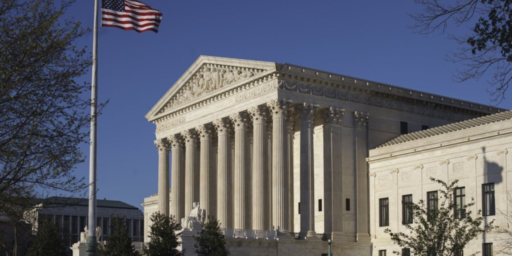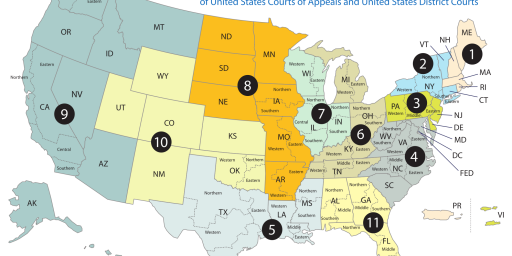Lower Courts Matter
Will Baude, writing at TNR Online, argues rather persuasively that federal appelate courts are much more important than the press would have us believe:
Because it can only rule on individual cases, not hypothetical ones, the High Court relies on lower courts to apply its logic and rules to new situations–and that gives circuit court judges the power to determine whether the logic behind any given Supreme Court ruling provokes a legal revolution or simply sputters out. Last month, in Blakely v. Washington, the Court held unconstitutional Washington state’s sentencing scheme because it put too much power in the hands of judges, as opposed to juries. At the time, the opinion was somewhat overshadowed by coverage of the Court’s terrorism decisions. But in recent weeks, Blakely has sparked immense activity in lower courts with far-reaching implications. The way lower courts have handled Blakely suggests just how much circuit court appointments matter.
One reason Blakely has sparked so much activity in lower courts is that the Federal Sentencing Guidelines–a set of rules adopted by Congress in 1984 to try to reduce sentencing inequality–raise a similar constitutional issue to Washington’s now-outlawed practices. While the justices acknowledged in a footnote to Blakely the possible contradiction between their ruling and the continued existence of the federal guidelines, they avoided deciding the issue. Since Blakely came down on June 24, more than 30 lower court opinions have wrestled with the constitutionality of the guidelines, making this what Professor Douglas Berman called last week on Slate “the biggest criminal justice decision … perhaps in the history of the Supreme Court.” The four dissenters in Blakely warned of this kind of upheaval, and now they have been proved right. Blakely has resonated throughout the system.
But it didn’t have to be this way. The lower courts could have read the decision more narrowly; pointed out that it didn’t necessarily apply to the Federal Sentencing Guidelines; and then, in the absence of a direct invitation from the Court, ignored the ruling’s broad implications. Indeed, sometimes they do precisely that. When the Court decided a pair of cases that curtailed the power of Congress over states, no legal revolution followed, despite similar warnings by dissenters and academics: The logic that struck down a gun-control law (Lopez in 1995) and a statute focusing on violence against women (Morrison in 2000) could have been extended to federal laws dealing with arson, pornography, and marijuana–but lower courts have largely failed to take the bait. (The Ninth Circuit has been a bit of an exception, striking down a handful of these laws, but nine years after Lopez, no legal revolution has come of it.)
He also cites some historical examples, notably the implementation of the 1954 Brown desegregation decision.
One thing Will doesn’t touch upon in his piece is that the lower courts are very influenced by state politics. District court judges are virtually all from the state in which they serve and are, for all intents and purposes, appointed by the U.S. Senators from their state rather than the president. Courts of Appeals judges almost all come up from one of the districts in the circuit and, again, the Senators from those states have substantial influence. School desegregation dragged on for over a decade precisely because the lower court judges refused to be aggressive in implementing Brown. Civil rights groups had to sue in school district after school district before the decision really took effect.






Historically — roughly pre-1976 — your comment about local senatorial influence in selecting federal district and court of appeals judges would have been accurate, although even then, life appointments plus long tenures significantly eroded the ties of gratitude running to, and corresponding implied influence of, senators. Since the Carter administration, however, the strong trend, regardless of which party controlled the White House or the Senate, has been to reduce senatorial influence in selecting nominees; for the most part, even senators of the President’s own party have had at most a quasi-veto over selections made by the White House, especially at the more important court of appeals level, in the last 25 years or so.
The Fifth Circuit judge for whom I clerked, Carolyn D. King, for example, was originally proposed to the Carter Administration by a “merit selection committee” headed by the then-managing partner of Baker & Botts — the oldest and one of the most conservative law firms in Texas (co-founded by the great grandfather of current bigfish partner James A. Baker III). She had begun her practice at Fulbright & Jaworski, another Texas megafirm that tends to be quite conservative; she was the ex-wife of another Baker & Botts partner; and she was the daughter of a Republican Commissioner of Insurance for the State of New York and the sister-in-law of then-Citicorp chairman Walt Wriston. Her law degree was from Yale; her practice had been not as a litigator (the traditional track), but as a corporate securities lawyer (mostly representing publicly traded corporations). These were hardly the credentials of a Democratic Party hack! By virtue of seniority, she’s now the Chief Judge of the Fifth Circuit — and although my opinion is far from unbiased, I think most knowledgeable observers would agree that she’s been a splendid judge and effective chief judge. But neither then-Senator Lloyd Bentsen nor John Tower was directly involved in her selection, and the idea that she’s ever owed an ounce of loyalty to either of them, or their political parties, is laughable to anyone who knows her.
Also, you’ve got it almost exactly backwards about the implementation of racial civil rights in the South. There were indeed lower court judges who were sluggish in implementing desegregation and other civil rights initiatives in the South, but for the most part that was at the district court level. Most of the real judicial heroes of the civil rights struggle were indeed the judges of the United States Court of Appeals for the Fifth Circuit — the pre-split version that included not only Texas, Louisiana, and Mississippi, but also then Georgia, Alabama, and Florida (which since 1980 have comprised the Eleventh Circuit) — joined by a precious few federal district judges (e.g., Frank M. Johnson of Alabama). In fact, it was the legacy of those pro-civil rights circuit judges — particularly those from Texas and Louisiana (John R. Brown, Irving Goldberg, and John Minor Wisdom) — that long delayed the much needed splitting of the Fifth Circuit, because powerful Mississippians objected to being lumped in with the more pro-civil rights judges of Texas and Louisiana. Jack Bass’ 1981 book Unlikely Heroes tells in considerable detail how it was these judges of the Fifth Circuit who actually did the “heavy lifting” required by Brown v. Board of Education.
Bah. WordPress appears to have deleted my em-dashes. Sorry for what look to be some run-on sentences in that post.